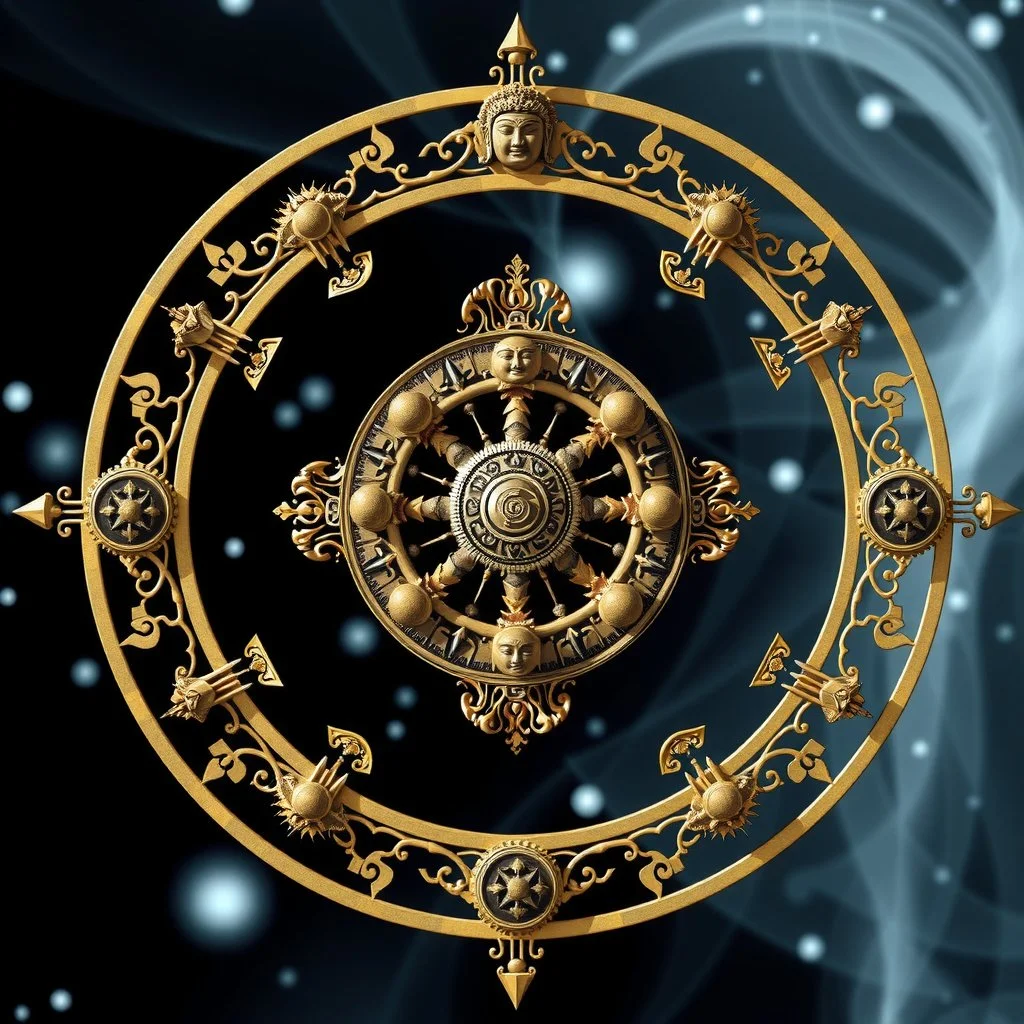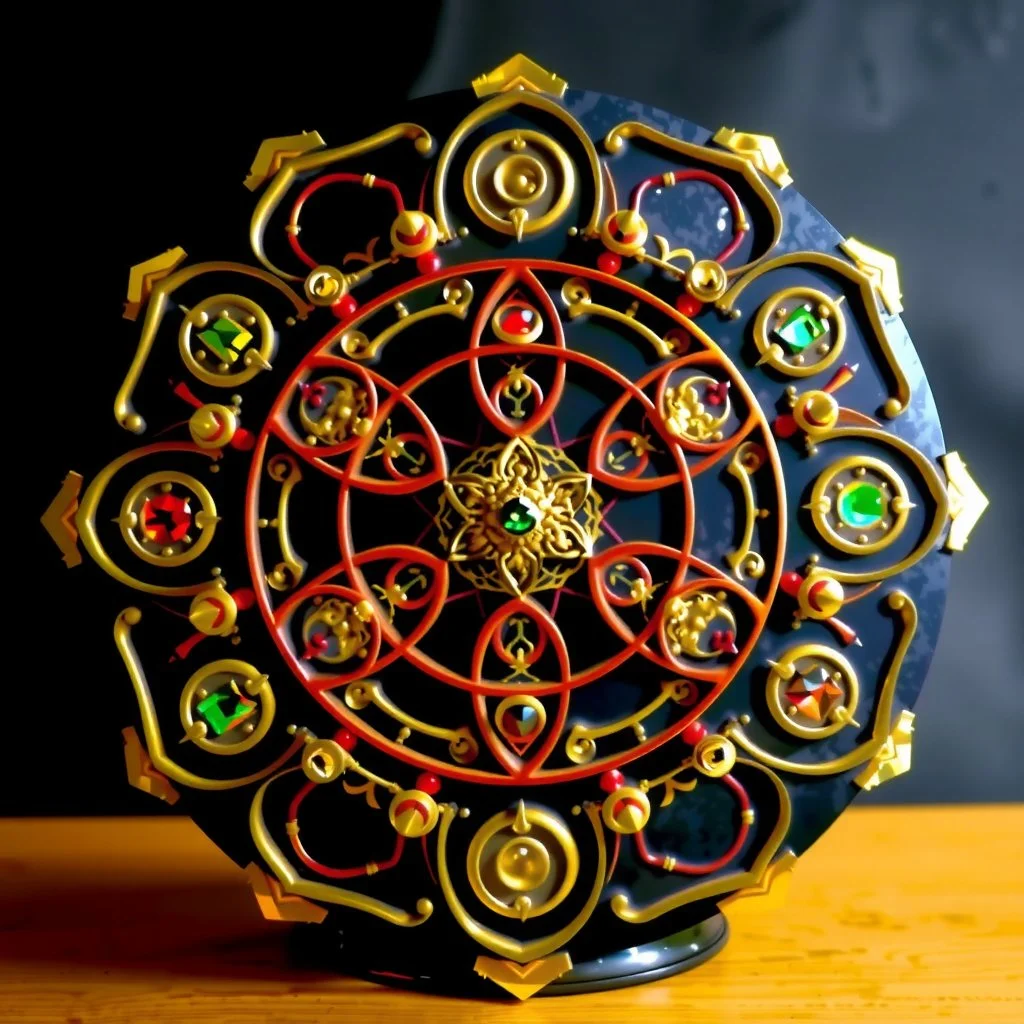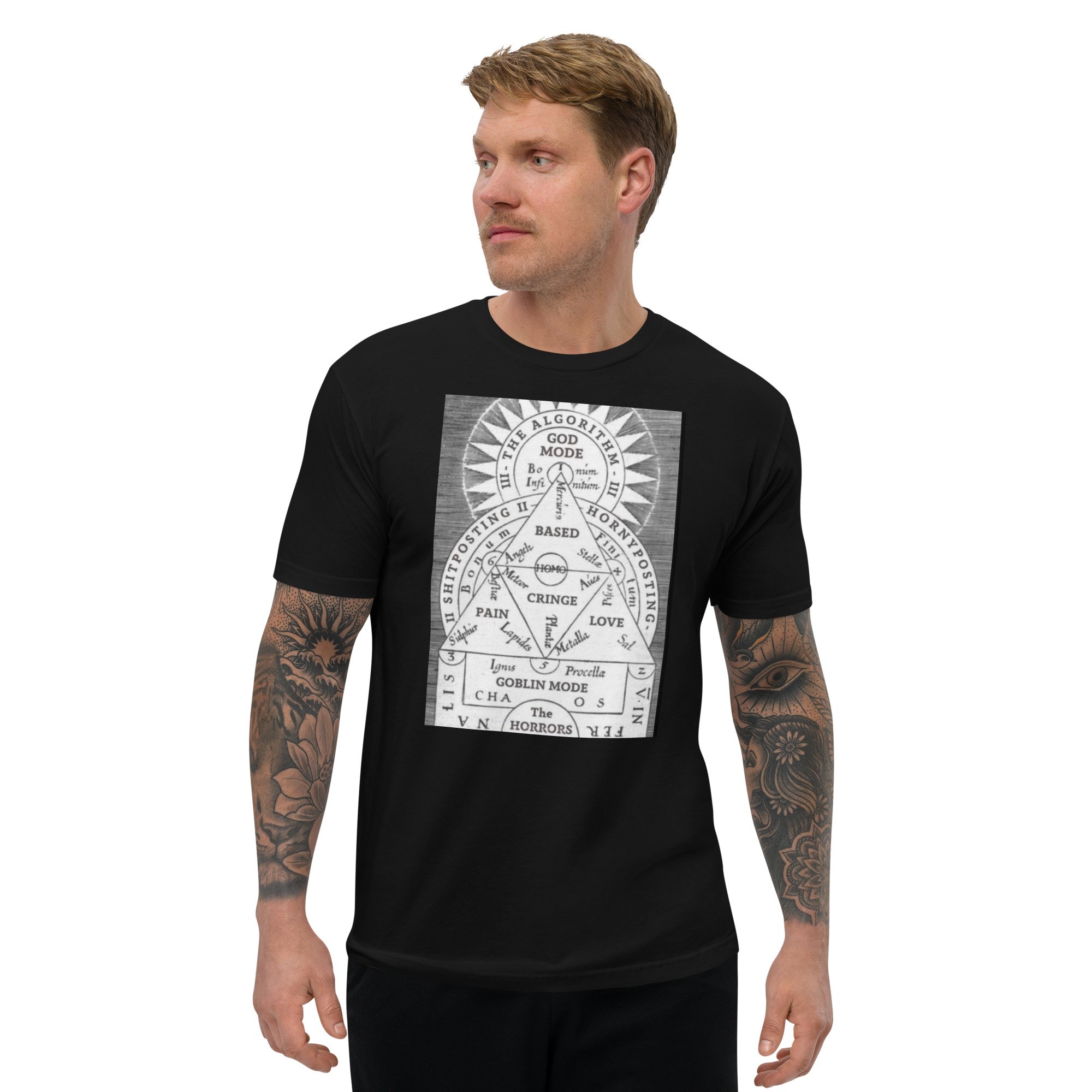The Mystical Symbolism of the Buddhist Wheel of Life
Abstract
The Buddhist Wheel of Life, known as the Bhavachakra, encodes a mystical teaching about the cycle of existence and spiritual liberation. This ancient symbol conceals esoteric significance beyond its exoteric depiction of the six realms. Understanding the deeper meaning hidden in its imagery provides keys to achieving enlightenment.
This essay unpacks the occult secrets of the Wheel, drawing parallels to other faith traditions to showcase consistent principles across ancient wisdom teachings. Decoding this roadmap to the absolute reveals how our own minds trap us in cyclic becoming and obscure the path to escape samsara. Awakening comes through transcending the forces that bind us to the wheel.
Introduction
The Buddhist Wheel of Life, known as the Bhavachakra, has captivated spiritual seekers for centuries. Traditionally painted at the entrance of Tibetan Buddhist temples, this vivid mandala depicts the endless cycle of birth and rebirth driven by karma. While its imagery may first appear cryptic, the wheel elegantly encodes the causes of suffering and pathways to freedom.
Believed to have originated with Buddha himself, the Wheel of Life serves both exoteric and esoteric purposes. On a basic level, it teaches fundamental Buddhist concepts like the six realms and dependent origination. Its graphic domains illustrate how karma determines where sentient beings take rebirth, from heavenly gods to the hells. For lay followers, it emphasizes moral living as the path to avoid lower realms.
At the same time, the Bhavachakra contains essential tantric teachings for initiates. Like the Kabbalistic Tree of Life or alchemical transmutation, it diagrams states of consciousness and energies that comprise the mindstream. By mapping inner forces that ensnare beings in samsara, it provides keys to achieving spiritual liberation. The wheel's profound symbology mirrors the practitioner's inner journey.
Few symbols capture the imagination like the Buddhist Wheel of Life. Painted at the entrance of every Tibetan gompa, this vivid mandala depicts the realms of cyclic existence in vivid color. Known as the Bhavachakra in Sanskrit, the Wheel of Life illustrates the causes of suffering and the pathway to freedom. While exoteric teachings emphasize the six realms, closer examination reveals occult anatomy hiding below the surface.
Like Kabbalah or alchemy, the Wheel encodes a mystical teaching about states of consciousness and the causes of bondage. This essay unpacks its symbology to unveil a mind map for achieving enlightenment. By elucidating its esoteric meaning and connection to other traditions, we trace the journey from samsara to nirvana.
The Wheel acts as a mirror, teaching us to recognize the forces that keep us trapped in illusion. Awakening comes through transcending the cycle. The Wheel shows us how.
The Exoteric Wheel
The Wheel depicts the six realms of samsaric existence:
Gods
Demigods
Humans
Animals
Hungry ghosts
Hells
These graphic domains illustrate where beings transmigrate based on karma. Gods enjoy heavenly delights in higher dimensions, while hell denizens suffer for misdeeds. Most humans cycle between realms based on ethical conduct. The imagery engenders moral behavior in viewers, showing virtuous paths lead up the Wheel and vice leads down.
The wheel turns through twelve nidanas symbolizing dependent origination. Just as rings spin around a wheel's axis, causal links spin the endless cycle of birth and rebirth. Delusions perpetuate suffering and rebirth. Only cutting this causal chain can end the rotation.
As scholar Robert Thurman (2005) explains: "These nidanas comprise a causal loop process whereby ignorance gives rise to volitional action, which gives rise to consciousness, name and form, and so on around again” (p. 17). This vicious cycle perpetuates samsara until transcended.
At the core, three forces drive the Wheel's rotation: greed, hatred, ignorance. These poisons motivate harmful conduct keeping the wheel turning. Eliminating these can stop the endless spin. Exoterically, the vivid depiction shows how flee the realms of suffering to attain higher rebirths. Yet esoteric secrets hide below the surface.
The Esoteric Meaning
Like Kabbalah, alchemy, and mysticism, Buddhism contains esoteric teachings disclosed only to initiates. The Wheel reveals its innermost secrets to those spiritually prepared. Beyond ethical precepts, it encodes a mind map for achieving enlightenment. The visual metaphors depict states of consciousness and forces binding us to illusion. By transcending these we can escape samsara.
The wheel shows our inner cosmos, not just outer worlds. Its realms, beings, and symbols reflect energies and parts of our own minds. Like Christ's parables, the vibrant imagery conceals universal principles realized through meditation. Granted, heavenly gods exist, but focusing on one's inner universe is more practical. As the Dhammapada states:
"We are what we think. All that we are arises with our thoughts."
Understanding the Wheel's inner workings illuminates the path to enlightenment.
Our Own Wheel We each have gods, demons, humans, and hungry ghosts in our minds - parts seeking pleasure, power, acceptance, and satiation of desires. Like the painting's imagery, our inner worlds interconnect through causal forces enslaving us to craving and aversion. Our minds are wheels constantly turning, fed by these inner forces.
Tracing this internal map helps cut the causal chain trapping us in illusion. Seeing our minds as a microcosmic Wheel reveals binding habits and where to target change. Like a mind mandala, its vivid parts represent energies we must master. Each realm and being symbolizes forces and subpersonalities making up our inner life.
For instance, demigods reflect envy, ambition, and competitiveness. Hungry ghosts depict addiction, craving, and insatiability. Hell beings are hatred, rage, and aggression. The Wheel depicts our inner forces elegantly. Seeing oneself in its imagery instills insights. Where do we put most time and energy? What parts dominate, uplift, or undermine us? Such self-reflection grants wisdom and power to choose differently. External battles start inside.
The Wheel and the Tree of Life
This depiction correlates to the Kabbalistic Tree of Life, which likewise diagrams consciousness and cosmic forces. Kabbalah describes four worlds of descending dimensionality: Atziluth, Briah, Yetzirah, Assiah. Like a lightning flash descending from the Source, manifestation unfolds across these planes. The Tree maps everything from Divine to infernal.
The Wheel corresponds to the lower realms of Yetzirah and Assiah. Like Jacob's ladder, the vertical Tree shows increasing dimensionality and purity ascending. The Wheel spins through horizontal rounds like the Tree's lower sephiroth. Both reveal the inner worlds our consciousness cycles through.
In both models, hells are the bottommost domains; heavenly god realms are upper. The central human, animal, and hungry ghost realms match Yetzirah, the World of Formation. Here desires, instincts, and emotions dominate like the Wheel's core. Transcending these realms starts by mastering the central trinity shadowing the upper sephiroth.
Both systems align in their structure and aim: to diagram consciousness across a vertical spectrum from gross to subtle. The Wheel distills essential principles of the Tree into a succinct teaching tool. Each offers ascending steps from baseness to divinity.
The wheel also mirrors the phases of alchemical transmutation. Like base metals transforming to gold, we purify consciousness by raising vibrations from gross to celestial. The Wheel shows the ladder between states of leaden desire and golden spirit. Refining ourselves transforms our inner cosmos, lifting us to our highest potential.
Secret Causes of Suffering
Public teachings emphasize good conduct and mindfulness as the keys to right living. Esoterically, desire, hatred and ignorance binding us to the Wheel have a secret inner meaning. These poisons symbolize forces below our ordinary awareness. Karma and rebirth are mystically tied to the misuse of energy.
Three types of energies flow through three channels in the subtle body. Known in Sanskrit as prana, chit, and shakti, these currents connect to body, speech, and mind. Energy - consciousness - power; these three forces comprise reality's fabric. Harnessing them consciously liberates, while mechanical misuse binds.
Herein lies the key difference between saints and sinners. Both access the three forces, but only saints convert them to benefit others. Sinners squander energies vainly, creating suffering. Like electricity, intrinsic forces can power either hospitals or execution chambers. How we utilize energy determines its effects. The wise harness the three for enlightenment.
Greed, hatred, ignorance depict egoism's effects on universal forces. Like warped lenses, the ego distorts innate cognition into grasping, aversion, and confusion. When consciousness identifies with temporary states, we lose sight of deeper truths. Attachment to desire, rejection of discomfort, and bypassing self-knowledge keep life's wheel turning.
We liberate from illusion by awakening awareness of these currents to align with truth, compassion, and inner divinity. Meditation grants this vision to see beyond egoic filters. Stilling our churning minds accesses pure view. Then energy unlocks its potential for freedom.
Secret Locks and Keyholes
Further occult anatomy hides in the symbols. The Wheel encodes tantric science veiled to protect sacred wisdom. Images that might appear arbitrary contain precise esoteric meaning.
The hub with its snakes, birds, and pig represents three nerve channels controlling the inner wheels. In yogic subtle physiology, ida, pingala, and sushumna comprise the body's core conduit system. Respectively, these currents regulate mental, vital, and psychic energy flows. Balancing them grants health, self-control, and stillness.
The wheel's segments mirror three granthis (knots) that must untie along the spinal column. Through inner work, releasing these energetic knots or chakra blockages allows awakening. Each seal locking the wheel's rotation corresponds to a bound plexus. Unbinding them unlocks the soul's flowering into liberation.
Anthropomorphic figures spread along the rim embody bindu points trapping consciousness in conditioned patterns. Studding the circumference like spokes, these nodes of attachment snare awareness in karmic cycles. Each being symbolizes a particular energetic knot including desire, anger, ego, jealousy, etc. releasing these fetters stops the wheel.
Finally, Yama, the wrathful deity clutching the wheel signifies the karmic lord managing our inner cosmos through time. His fangs and skull adornments depict impermanence and necessary death of the ego. To escape samsara's cycles requires surrendering every transient self-concept skandhas creating separation. Only by relinquishing limited identities do we merge again with our eternal source and exit the wheel.
Collectively, the imagery portrays an occult map to enlightenment: opening channels, untying knots, releasing bindus, surrendering self-concepts. This inner technology grants bodhi or awakening. The key turns through understanding mind as the matrix of reality.
The Two Paths
Importantly, Buddhism among other faiths distinguish two roads of evolution: a gradual "spiral path" and sudden “straight path." The Wheel signifies souls ripe for quick liberation through profound inner work. Meandering lifetimes slowly refine souls toward awakening. The subtler straight path transcends eons of wandering.
This direct journey centers on utilizing energies consciously rather than mechanically. Most squander vitality on desire, fear, and avoidance. The straight path preserves these forces for rapid transformation. Like a spiritual rocket, stored energies propel consciousness to escape velocity. This demands exceptional discipline, austere habits, focused practice, and determined self-mastery.
Such accelerated evolution requires high preparedness and suitability; few qualify today. For most seekers, a progressive spiral ascent remains appropriate. Here the Wheel's cause and effect teachings help mature souls toward readiness for liberation. These earnest students slowly revolve until conditions ripen for escape velocity. The path of Renunciation refines consciousness gradually through virtue.
But for the few ready and willing, the straight path beckons. Through radical self-honesty and personal accountability, seekers walk the razor's edge toward timeless awakening. Their struggles dwarf ordinary worldly conflict. Assailing the fortress of ego demands every drop of courage and intent. Alone and unsupported, they scale the citadel walls. Theirs is a hero's journey into the unknown. Cause for pause? Certainly. But the soul ripe for freedom heeds one call only.
The Narrow Gate
Emphasizing conduct misses the deeper aim: to escape samsara entirely. Moral living mitigates suffering but obscures enlightenment's entrance. Fixating on realms and ethics overlooks the inconceivable Absolute beyond causality. Like Jesus' camel passing through the needle's eye, we must shed everything to squeeze through.
Freedom hinges on renunciation - abandoning the causative self that keeps cyclically becoming. Neither black nor white paths lead out; the straight track transcends both. Radical letting go of all limiting identities and concepts springboards from the wheel. Not skeptical avoidance nor forced submission succeeds; radically releasing all through empty wisdom is the gate's mysterious key.
This cannot be grasped by thought. Beyond causality or extremes dwells the nondual Ain, Ayin. Forever emerging yet never expressed, devoid of attributes yet imbued with each one, this 'Silent Stillness' is hidden. Buddha nature shines silently when ego dissipates. Merging in this Great Mystery finds the journey's end. No further signposts remain.
The Tenth Arcanum
In esoteric Christianity, the Tenth Arcanum encapsulates the same teachings. Various traditions encode universal principles through their own symbology. The Arcanum's Wheel of Destiny mirrors the spinning Bhavacakra.
Ten circles along the rim embody the Sephiroth of the Tree of Life, each a world unto itself. A sphinx represents the first created man Adam overlooking his dominion. Serpents below portend a coming fall. The wheel appears upheld by Anubis, Egyptian god of death and the underworld.
This vivid tableau captures humanity's deity, divinity and destiny. Created noble, yet destined to fall, we remain bound to the wheel's cycles until awakening. Only through death of the ego do we unify again with the Absolute above the rim. Anubis reminds us that escaping samsara requires willingly facing annihilation of the transient self.
Additional figures reveal humanity's plight. A blindfolded woman walking unchanged conveys ignorance of the work required for liberation. Her imbalance signifies a confused mind grasping for answers. A devilish figure watches amused by our suffering, rebellion, and denial. Meanwhile, an angel above prepares to sound his trumpet and shake the wheel when the time arrives. For now, humanity remains enthralled.
Awakening
Through ongoing self-reflection, we recognize habits and energies sustaining our karmic patterns. Observing the mind's endless desires and aversions that keep awareness bound to ephemeral appearances provides keys for release. Gradually we stop reacting blindly and instead respond with wisdom. This weakens binding forces until their grip breaks entirely.
At first, moments of lucidity offer glimpses of freedom, openness, and creative potential. Gradually, unbound awareness becomes our base perception. When consciousness ceases clinging to momentary arisings, we recognize ultimate Truth pervading reality's fabric. No separate self remains to revolve helplessly. Instead, we see through the illusory Wheel as merely foam atop an endless ocean.
In rare moments of high attainment, we almost appear to willingly re-enter the cycle for the benefit of other trapped beings. But unlike before, these emanations retain their awakened connection at all times. Their sublime play arrests the wheel's spin wherever they step, rescuing lost beings. To the bound they appear as magicians transforming poison into ambrosia. These awakened avatars brightly darken the wheels they touch.
By honorably walking the path ourselves, we prepare to benefit all beings one day. By striving for even brief instants of awakening, we set the wheel's momentum toward realignment. Small victories accumulate as stronger habits. In time, we internalize the boundless inner freedom known by awakened ones.
Their grace guides us along the path toward realizing this personless truth for ourselves, ultimately to awaken each sleeping mind from its karmic dream. One by one, enlightened beings light the wheel from within, until all beings gain liberation from the cycle of unnecessary suffering. The wheel spins on, but limited grasping ceases. By ceasing to react, we realize this unborn nature is ever present, awaiting rediscovery.
Conclusion
The profound Bhavachakra reveals humanity's plight and promise. Portraying consciousness trapped in cyclic becoming, it illuminates causes of suffering while indicating the path to freedom. Understanding our minds as a microcosmic wheel grants insights and provides a vision of awakening from delusion. Seeing the stunning mandala as a mind map supports releasing attachments and dissolving ignorance.
Letting go of transient self concepts and awakening to our essential Buddha nature aligns our inner forces to serve wisdom and compassion. Gradually we transcend the causes that bind most souls to helpless revolving. By unraveling secret meanings in the Wheel, its teachings propel our journey to enlightenment, bringing blessing to all beings.
References
Dhammapada 1 (Buddharakkhita, trans.). (1985). Retrieved from https://www.accesstoinsight.org/tipitaka/kn/dhp/dhp.intro.budd.html
Moore, T. (2004). Dark nights of the soul: A guide to finding your way through life's ordeals. Penguin.
Norbu, C., & Clemente, A. (1999). The supreme source: The fundamental tantra of the Dzogchen Semde Kunjed Gyalpo. Snow Lion Publications.
Thurman, R. A. (2005). The Tibetan book of the dead: Liberation through understanding in the between. Simon and Schuster.
Trungpa, C. (2003). The collected works of Chögyam Trungpa: Volume eight. Shambhala Publications.



































































